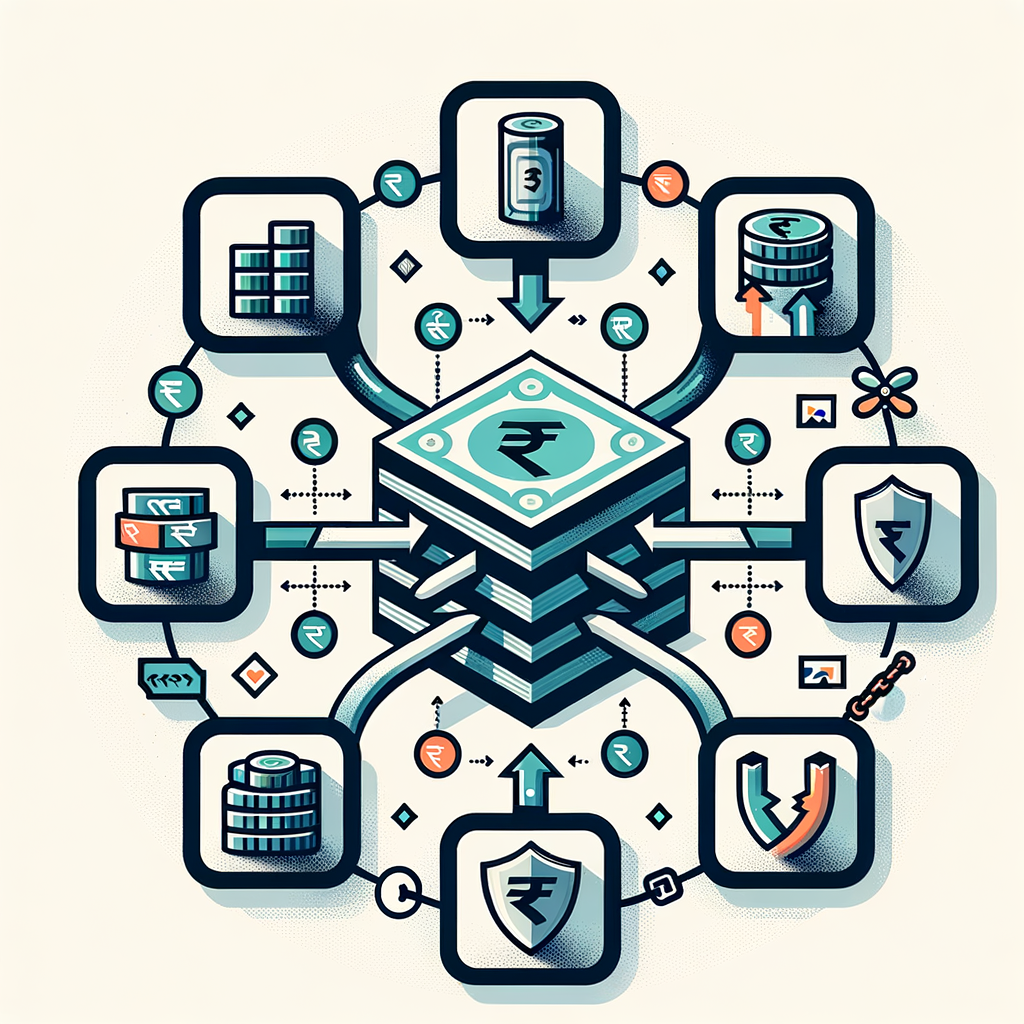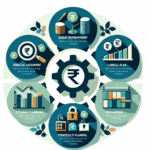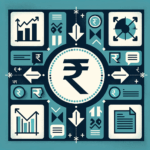The Pros and Cons of Debt Consolidation: What You Need to Know
Juggling multiple EMIs, credit card bills, and personal loan payments can feel like a financial circus act. Each payment has a different due date, a different interest rate, and a different set of rules. It’s overwhelming, stressful, and easy to lose track, leading to missed payments and mounting late fees. If this sounds familiar, you might have come across the term ‘debt consolidation’. This financial strategy can be a lifeline for many, but it’s not a one-size-fits-all solution. Understanding the debt consolidation pros and cons is crucial before you decide if it’s the right move for your financial health. This guide will provide a balanced view, exploring the debt consolidation pros and cons India-style, to help salaried individuals and small business owners make a smart, informed choice.
So, What is Debt Consolidation in the Indian Context?
At its core, debt consolidation is the process of taking out a single, new loan to pay off several other existing debts. Think of it as bundling all your smaller, high-interest debts—like credit card balances, multiple personal loans, or consumer durable loans—into one larger, more manageable loan. The primary goal is to simplify your finances so you only have to worry about one EMI each month. Answering what is debt consolidation India involves understanding this simple mechanism.
The process typically works in four steps:
- Assess Your Debts: First, you list all your current outstanding debts. Note down the principal amount, the interest rate, and the remaining tenure for each one.
- Apply for a Consolidation Loan: You then apply for a new loan (usually a personal loan or a loan against property) for an amount large enough to pay off all your existing debts combined.
- Pay Off Existing Debts: Once your new loan is approved and disbursed, you use the funds to completely pay off all your smaller, individual debts.
- Repay the Single Loan: Now, you are left with only one loan and one EMI to pay each month, making your financial management much simpler.
The Benefits of Debt Consolidation in India (The Pros)
When executed correctly, exploring the benefits of debt consolidation India reveals several powerful advantages that can help you regain control of your finances. It’s more than just a convenience; it can be a strategic move to improve your long-term financial stability.
Simplified Financial Management
One of the most immediate and significant benefits is simplicity. Instead of tracking three credit card due dates, two personal loan EMIs, and a consumer loan payment, you now have just one EMI on one fixed date. For busy salaried professionals and small business owners, this is a game-changer. It drastically reduces the risk of accidentally missing a payment, which in turn saves you from hefty late payment fees and penalties that can quickly spiral out of control. A single payment is easier to budget for and manage, bringing a sense of order to chaotic finances.
Potentially Lower Interest Rates
High-interest debts, especially credit card balances, are a major financial drain. In India, credit card interest rates can soar to 30-40% per annum. Debt consolidation allows you to convert these expensive debts into a single loan with a potentially much lower interest rate. For example, consolidating ₹3 lakh of credit card debt at 36% p.a. into a personal loan at 14% p.a. can save you a substantial amount in interest payments every single month, freeing up cash flow for savings or other essential expenses.
Improved CIBIL Score Over Time
While taking on a new loan might cause a minor, temporary dip in your CIBIL score due to a hard inquiry, the long-term effects of debt consolidation are overwhelmingly positive. By paying off multiple loans and credit cards, you effectively close those accounts, which can simplify your credit profile. More importantly, making consistent, on-time payments for your new consolidated loan demonstrates responsible credit behaviour. Over time, this positive payment history will significantly boost your CIBIL score. For more information on how credit scores work, you can visit the official CIBIL website.
Fixed Repayment Schedule and Tenure
Unlike the revolving nature of credit card debt where your minimum payment can change, a consolidation loan comes with a fixed EMI and a predetermined tenure. You know exactly how much you need to pay each month and exactly when you will be debt-free. This predictability is invaluable for budgeting. For both salaried individuals planning their monthly expenses and small business owners managing cash flow, a fixed repayment schedule provides the stability needed to plan for the future with confidence.
The Drawbacks and Risks of Debt Consolidation (The Cons)
While the benefits are attractive, it is absolutely essential to look at the other side of the coin. A thorough analysis of the debt consolidation pros and cons reveals potential pitfalls that could leave you in a worse position if you’re not careful. This isn’t a magic wand for debt; it’s a financial tool that carries its own set of risks.
The Risk of a Longer Repayment Period
To make the new EMI amount affordable, lenders often extend the loan tenure. A lower monthly payment might seem like a relief, but it means you will be in debt for a longer period. A three-year high-interest debt might be converted into a five or seven-year low-interest loan. While this eases your immediate monthly burden, it prolongs your financial obligation, which can impact your ability to take on other important loans, like a home loan, in the future.
Potentially Higher Overall Interest Payout
This risk is directly linked to the longer repayment period. Even if your new loan has a lower interest rate, extending the tenure can mean you end up paying more in total interest over the life of the loan.
Here’s a simple illustration:
| Scenario | Loan Amount | Interest Rate | Tenure | Total Interest Paid |
|---|---|---|---|---|
| Old Debt | ₹2,00,000 | 18% p.a. | 3 Years | ₹61,500 |
| New Loan | ₹2,00,000 | 14% p.a. | 5 Years | ₹79,300 |
As you can see, despite the lower interest rate, the longer tenure results in paying almost ₹18,000 more in total interest. Always calculate the total cost of the loan, not just the EMI.
Upfront Costs and Fees
Debt consolidation isn’t free. The new loan will likely come with a processing fee, which is typically 1-3% of the loan amount. Additionally, your old loans might have prepayment or foreclosure charges that you’ll need to pay to close them. You must factor these upfront costs into your calculations. Sometimes, these fees can be significant enough to reduce or even negate the savings you were hoping to achieve from a lower interest rate.
The Temptation to Accumulate More Debt
This is perhaps the biggest behavioural risk. After you’ve used the new loan to pay off your credit cards, you suddenly have a zero balance and a full credit limit available. It can be incredibly tempting to start swiping them again. If you haven’t addressed the underlying spending habits that led to the debt in the first place, you risk falling into a dangerous trap. You could end up with the new consolidation loan and new credit card debt, putting you in a far deeper financial hole than before. This is a critical debt consolidation tip for Indians: discipline is non-negotiable.
Common Debt Consolidation Solutions in India
If you’ve weighed the pros and cons and decided to proceed, it’s time to explore the practical debt consolidation solutions India offers. The best option for you will depend on your financial situation, credit score, and the type of debt you have.
Personal Loans
- Who it’s for: This is the most popular option for salaried individuals and business owners with a good CIBIL score (typically 750+).
- How it works: A personal loan is an unsecured loan, meaning you don’t need to provide any collateral. You get a lump-sum amount with a fixed interest rate and a fixed tenure (usually 1-5 years). You use this amount to pay off your credit cards and other smaller debts, then focus on repaying the single personal loan EMI.
Balance Transfer on Credit Cards
- Who it’s for: Best for individuals whose primary debt is on multiple high-interest credit cards.
- How it works: Some banks offer to transfer the outstanding balances from your other credit cards to a new card. This new card often comes with a low or 0% introductory interest rate for a promotional period (e.g., 3-6 months). This gives you a window to pay down the principal aggressively. However, be cautious: once the promotional period ends, a very high interest rate usually kicks in.
Loan Against Property (LAP)
- Who it’s for: Primarily for small business owners or individuals who own a residential or commercial property.
- How it works: This is a secured loan where you mortgage your property as collateral. Because the loan is secured, you can often get a much larger loan amount at a significantly lower interest rate and for a longer tenure compared to a personal loan. However, this is a high-risk option. If you default on your payments, the lender has the right to seize and sell your property to recover their money.
Final Debt Consolidation Tips for Indians
Before you sign on the dotted line, keep these essential tips in mind to ensure your consolidation journey is successful.
- Tip 1: Do the Math: Don’t just look at the lower EMI. Use an online loan calculator to determine the total interest you’ll pay over the entire tenure of the new loan. Compare this with the total interest you’d pay on your existing debts. Remember to include all processing fees and prepayment penalties.
- Tip 2: Check Your CIBIL Score: Your CIBIL score is the single most important factor in getting approved for a low-interest consolidation loan. Check your score beforehand. Understanding How to Track Your Credit History Using Your PAN Card Via CIBIL is the first step. If it’s below 750, work on improving it before you apply to get the best possible interest rate.
- Tip 3: Read the Fine Print: Carefully review the loan agreement. Look for hidden charges, clauses about variable interest rates that could increase later, and penalties for making prepayments on the new loan.
- Tip 4: Create a Budget and Stick to It: Debt consolidation is a tool, not a cure for poor financial habits. The real solution is to learn about Effective Budgeting Techniques to Reduce and Eliminate Debt, create a strict budget, track your spending, and stop accumulating new debt. Cut up the old credit cards if you have to!
Conclusion
The debt consolidation pros and cons clearly show that it is a double-edged sword. For the disciplined individual who uses it as a strategic tool to simplify payments, lower interest costs, and get on a clear path to becoming debt-free, it can be incredibly effective. However, for someone who sees it as an easy way out without changing their spending habits, it can become a trap that leads to an even bigger debt burden.
Ultimately, whether debt consolidation is a smart move depends entirely on your personal financial situation and your commitment to fiscal discipline.
Feeling overwhelmed by debt? The financial experts at TaxRobo can help you analyze your situation and find the right path forward. Contact us today for a consultation.
Frequently Asked Questions (FAQs)
1. Will debt consolidation hurt my CIBIL score in India?
Initially, there might be a small dip in your CIBIL score. This happens for two reasons: a “hard inquiry” is made when you apply for the new loan, and closing several old credit accounts can slightly reduce the average age of your credit history. However, this is a short-term effect. If you make all your payments on the new consolidated loan on time, your score will improve significantly in the long run due to a consistent positive payment history and a more streamlined credit profile.
2. What is the difference between debt consolidation and debt settlement?
Debt consolidation and debt settlement are very different.
- Debt Consolidation: You take a new loan to pay off your existing debts in full. Your credit score improves over time with timely repayments.
- Debt Settlement: You negotiate with your creditors to pay back only a portion of what you owe. The remaining amount is forgiven. While this may seem appealing, it severely damages your credit score for up to seven years and makes it very difficult to get new loans. You can learn more by reading our guide, Debt Settlement Explained: Pros, Cons, and Alternatives.
3. Which type of debt is best suited for consolidation?
High-interest, unsecured debts are the best candidates for consolidation. This most commonly includes:
- Credit card balances
- Personal loans
- Consumer durable loans (for electronics, appliances, etc.)
It generally doesn’t make sense to consolidate secured, low-interest debts like a home loan or a car loan.
4. What documents are typically required for a debt consolidation loan in India?
The documentation is similar to any other personal loan. Generally, you will need:
- KYC Documents: PAN card, Aadhaar card, proof of address.
- Proof of Income: Latest 3-6 months’ salary slips and Form 16 (for salaried individuals); latest 2-3 years’ Income Tax Returns (ITR) and business financials (for self-employed/business owners).
- Bank Statements: Last 6 months’ bank statements showing your salary or business income.
- Existing Debt Documents: Statements for all the credit cards and loans you intend to pay off, showing the current outstanding amount.



